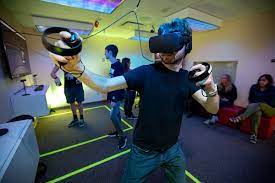The timeline of virtual reality has an intertwining development of VR for education and VR for entertainment. Most people who engage with virtual reality engage with the entertainment side of it, but the educational side of VR has evolved right alongside that of the entertainment. The education side of VR is continuously saving lives through teaching in a safe and humanless context.
Entertainment
The roots of modern virtual reality can be seen as far back as the 1830s with stereoscopic photos and viewers. Virtual reality was much, much later developed into Morton Heilig's Sensorama in 1962. The Sensorama was, for all intents for all intents and purposes, a virtual reality arcade cabinet used for the viewing of movies using all of your senses. In the early 90s, video games took a keen interest in VR. Companies like Sony and Nintendo attempted to get a foothold into the technology, but it wasn't until the 2010s that the technology and the games industry had advanced far enough to make a consistently successful industry in VR hardware and software for the uses of entertainment.
Education
In 1929, the first practical application for VR was created in the form of the first flight simulator used to train pilots. Virtual reality was further changed in 1968 with the development of the first head-mounted VR display and further still in 1979 with the first standalone VR headset that could be removed from a lab setting. Today, education VR has developed far past that of VR made for the average consumer.
Impact
Virtual reality received huge loops in technological advancements as a result of the technology being used as training. The technology got its original boom in the field of training technology, beginning with flight trainers and getting developed further in the military and especially in the field of healthcare to train surgeons on complex procedures.
A large portion of the field today is dedicated to entertainment, specifically video games. This has pros and cons. A pro is simply that it is fun for the consumer. The development of new video games relating to VR as well as hardware to complement these games has led to an extremely enjoyable new medium for those who are involved in it. A con to this is the lack of further development unless stimulated by financial promise. This means development of hardware is slow for the consumer as the VR entertainment market has a high financial entrance barrier.
Unfortunately, virtual reality's previously mentioned financial barrier of entry has led to a lack of expansion in the industry. Those looking into VR have to buy a headset, and a powerful computer (if they wish to play more graphically intensive games), and must have room set aside to play VR. Additionally, modern VR faces a similar problem as older VR did, namely motion sickness. The feeling of virtual moving while standing still is simply too much for a lot of people to handle, meaning the already small market of people able to afford and wanting to engage with VR has been shortened even further.




No comments:
Post a Comment